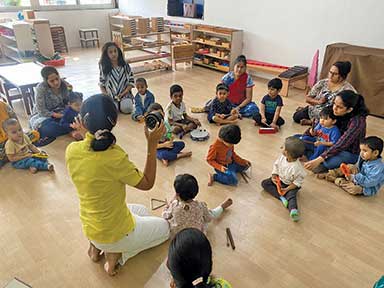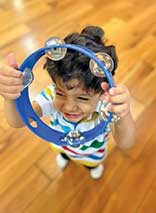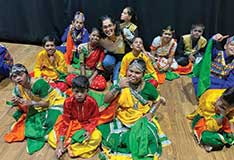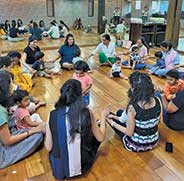Deepika Nandal
One of my fondest memories from my growing up years is us siblings sitting in a circle, having a meal together, talking about the day and ending up laughing out loud. It felt like a relaxing exercise, and it really helped us solve our sibling egos too. This simple activity – that lasted at least 30 minutes – used to balance things out for us and showed us how life is not really about the complicated things and the fact that it can be simple and fun.
When I started a storytelling session in Mumbai, I realized how important it is to set the tone for kids and just make them better at listening. For that, I used circle time. That made me realize the power of music and other activities that we did through our circle time and how kids just saw each other and grasped more.

When it comes to the classrooms, learning centres, homeschooling, or even informal educational setups, circle time can provide an excellent tool to teachers, wherein they allow kids to explore, be more vocal, and provide different ways to boost sensory and overall brain development. You can be as creative as you want as a teacher and kids can grasp so much, without having to follow any rules. Though a tool, circle time is an open-ended learning experience that can help kids bloom, and how!
“Circle time is a non-traditional way of learning. It brings with it an element of fun and when children are having fun, they have a better chance at retaining what they have learned,” says Mariam Zaidi, a Waldorf teacher based in Wimbledon, Southwest London. Mariam has two kids (8 and 2), and she currently, homeschools her older kid. Her YouTube channel (@WaldorfWithMariam) is her new learning venture where she shows interactive ways of making the most of circle time. While there are various ways in which teachers can utilize this exercise, music is an easy and effective way of igniting young minds. “When young children sit, participate, and observe each other in a circle, they experience a feeling of connectedness,” says Priyanka Seth Pandit, a Mumbai-based educator and director at The Music Circle, a music education organization in Mumbai. “And when they are making music in a circle, that energy of joy, social interaction, and connection is further enhanced,” she adds.
When done on a routine basis, teachers can introduce various concepts and a free-exchange chat that adds wings to their constrained thinking. “For children up to seven years of age, rhythm and repetition are very important. Being able to anticipate what comes next provides children with a sense of security, and through repetition they learn and retain new concepts. For older children, it is a part of the day where they relax and in Waldorf terms, breathe out,” says Mariam. “Providing a ‘breathe in and breathe out’ rhythm throughout the day is essential to provide a balance of activities and prevent the children from engaging in too much head work where they are taking in and processing information,” she adds.

A musical session with stories and props
For Priyanka – a trained teacher in the US to teach music together to little ones – it’s all in the details that makes a larger impact on kids. “We use a variety of props. In terms of musical and percussion instruments, we use egg shakers (baby maracas), rhythm sticks, jingle bells, hand bells, triangles, and resonator bells, as well as a bagful of mixed percussion instruments like tambourines, castanets, clappers, tick tock blocks and any local instruments we may find. In terms of props, we use scarves, puppets, balls, TheraBands, kitchen pots and other utensils that are great for making music. We even have a variety of storybooks that are set to a tune. There is music and rhythm everywhere if you look for it,” says Priyanka. All this become a part of a session that might go from 30 to 45 minutes. “Each 30-minute session is carefully planned and curated to include a good balance of small and large motor songs, props, diverse tonalities, and rhythms, as well as calming and energizing songs. Lesson planning is a fine art,” adds Priyanka.
Beyond theory
Teachers who want to help kids become independent and problem solvers too can make the most of circle time to combat their riddles and issues that hold them back. “Circle time is like a remedial tool. Actions that involve crossing the midline (as in right and left side of the body) can help with handwriting development. Different animal movements in songs can help with retained primitive reflexes,” says Mariam. Overall, it makes kids more alert towards their environment and helps absorb what’s around them faster. “The teacher can use an object and pass it around the circle for children to hold and speak (when their turn comes) about anything they would like to. This can encourage children to raise issues they may have with one another and discuss them in a safe space,” adds Mariam.

Music for soulful learning
Priyanka has extensive work experience in Mumbai and New York and has mastered how music can benefit kids. From setting curriculums to knowing what it takes to appreciate music, she can just create a learning environment for kids through music that can lend maximum impact on young minds. “Music through movement can develop language skills (spoken/sung language, pre-literacy activities, picture books, song tales, active listening and familiarity with print materials), cognitive growth (through spatial awareness skills, numerical literacy activities, study of animals and plants, problem solving and improvisation based creative activities), emotional growth (brings visible joy, has activities that allow self-expression, has activities that help children identify their uniqueness and respect the uniqueness of others), social growth (activities that foster a learning community, to respect the community and environment they live in and to give children opportunities for leadership and role development. Activities of daily health, sanitation and nutrition included), and lastly, physical skills (movement and body awareness, fine motor skills, gross motor skills specific to a pre-primary age group),” lists down Priyanka.

Circle time for homeschooling
Mariam likes to believe that circle time is something that can be done alone when you’re with your child as well. And you don’t really need groups for the same. Content is important and it is also essential that you have the right material for your child. “Circle time at home is beautiful because we can entirely tailor circle time based on our child’s needs or interests. There are plenty of songs, verses, and games that can be done alone or with a partner and the partner can be you. Sometimes you might need to tweak the songs or activities to suit the home setting and in doing so, you’re demonstrating versatility and adaptability to your child. If you can find a community and come together for circle time once a week, that is great but if not, you can do it alone,” says Mariam, who has also run Waldorf support group for parents in the past. She actively shares her knowledge on her social media pages.
Circle time can break concepts down for kids and help them grasp knowledge and put their attention to detail without force. Having said that, circle time also lightens the overall mood of the class and allows kids to absorb things at their own speed. Encourage kids to explore subjects and new skills through an interactive circle time session and open up their minds to a wider segment of knowledge. As play specialist O. Fred Donaldson rightly said, “Children learn as they play. Most importantly, in play children learn how to learn.”
The author is a Gurgaon-based freelance writer. She loves writing about food and people around the globe. Her two kids inspired her to start storytelling sessions when she lived in Mumbai with @little.book.explorers. She loves sharing her thoughts about food on her blog,
tastememory.blog.
